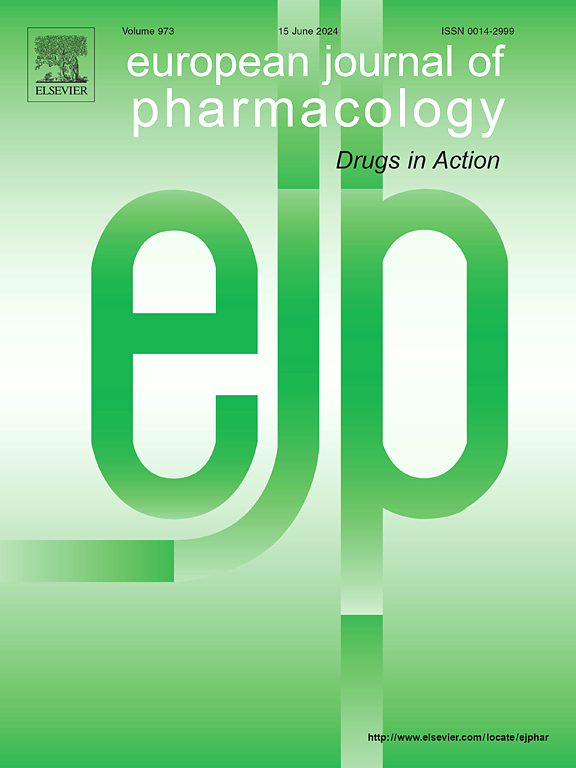胰高血糖素样肽-1受体参与非瑟汀四甲基醚增强MIN6细胞胰岛素分泌
IF 4.2
3区 医学
Q1 PHARMACOLOGY & PHARMACY
引用次数: 0
摘要
背景:Pongamia pinnata (L.)皮埃尔,长期以来被用作治疗糖尿病和代谢紊乱的传统药物,显示出胰岛素的作用。目的:研究桄子花提取物非瑟酮四甲基醚(FTM)的抗胰岛素特性及其作用机制。方法:采用胰腺β细胞系MIN6检测FTM的促胰岛素特性,采用胰岛素法检测分泌胰岛素和残留胰岛素。此外,使用ATP测定、Ca2+通量测定、免疫印迹分析以及胰岛素药物抑制剂测定来检查潜在的机制。结果:FTM增加胰岛素分泌呈剂量依赖性。此外,无论是否存在FTM, 10 mM或更多的葡萄糖都会增加胰岛素分泌。尼莫地平是一种电压依赖性钙通道拮抗剂,完全消除葡萄糖和FTM诱导的胰岛素分泌。然而,FTM治疗对ATP和细胞内Ca2+水平的影响很小,表明其增强了独立于葡萄糖代谢的葡萄糖刺激胰岛素分泌(GSIS)。此外,新开发的胰高血糖素样肽-1 (GLP-1)受体拮抗剂VU0650991可降低ftm增强的GSIS。此外,ftm增强的GSIS可被barbadin (β-arrestins介导的信号通路抑制剂)和GSK215(局灶黏着激酶(FAK)的降解剂)降低,但不能被HJC0350(参与胰岛素颗粒胞吐的cAMP 2激活的交换蛋白抑制剂)所抑制。结论:GLP-1受体-β-阻滞蛋白/FAK通路参与了ftm增强的GSIS。本研究表明,枫香提取物是一种具有GLP-1受体拮抗潜能的促胰岛素植物化学物质。本文章由计算机程序翻译,如有差异,请以英文原文为准。
Involvement of glucagon-like peptide-1 receptor in fisetin tetramethyl ether-enhanced insulin secretion in MIN6 cells
Background
Pongamia pinnata (L.) Pierre, long used as a traditional medicine to treat diabetes and metabolic disorders, shows an insulinotropic effect.
Objective
This study aimed to determine the insulinotropic property and underlying mechanism of a constituent of Pongamia pinnata, fisetin tetramethyl ether (FTM).
Methods
The insulinotropic property of FTM was investigated using pancreatic beta cell line MIN6, while secreted insulin and residual insulin were detected by an insulin assay. Furthermore, the underlying mechanism was examined with use of an ATP assay, Ca2+ flux assay, and immunoblot analysis, as well as the insulin assay with pharmacological inhibitors.
Results
FTM increased insulin secretion in a dose-dependent manner. In addition, 10 mM or more of glucose increased insulin secretion regardless of the presence of FTM. Nimodipine, a voltage-dependent Ca channel antagonist, completely eliminated insulin secretion induced by glucose and FTM. However, FTM treatment had minimal effects on ATP and intracellular Ca2+ levels, suggesting its enhancement of glucose-stimulated insulin secretion (GSIS) independent of glucose metabolism. Additionally, a newly developed glucagon-like peptide-1 (GLP-1) receptor antagonist, VU0650991, reduced FTM-enhanced GSIS. Moreover, FTM-enhanced GSIS was reduced by barbadin, an inhibitor of the β-arrestins-mediated signaling pathway, as well as GSK215, a degrader of focal adhesion kinase (FAK), though not by HJC0350, an inhibitor of exchange protein activated by cAMP 2 involved in insulin granule exocytosis.
Conclusion
The GLP-1 receptor-β-arrestins/FAK pathway is involved in FTM-enhanced GSIS. This study showed that FTM, a constituent of Pongamia pinnata, is an insulinotropic phytochemical possessing biased GLP-1 receptor agonistic potential.
求助全文
通过发布文献求助,成功后即可免费获取论文全文。
去求助
来源期刊
CiteScore
9.00
自引率
0.00%
发文量
572
审稿时长
34 days
期刊介绍:
The European Journal of Pharmacology publishes research papers covering all aspects of experimental pharmacology with focus on the mechanism of action of structurally identified compounds affecting biological systems.
The scope includes:
Behavioural pharmacology
Neuropharmacology and analgesia
Cardiovascular pharmacology
Pulmonary, gastrointestinal and urogenital pharmacology
Endocrine pharmacology
Immunopharmacology and inflammation
Molecular and cellular pharmacology
Regenerative pharmacology
Biologicals and biotherapeutics
Translational pharmacology
Nutriceutical pharmacology.

 求助内容:
求助内容: 应助结果提醒方式:
应助结果提醒方式:


